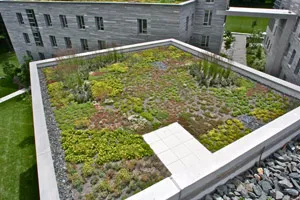Swarthmore Cited as One of America's Greenest Schools

US News & World Report: 8 Colleges That Are Energetic About Going Green
The Princeton Review, in collaboration with the U.S. Green Building Council, recently praised the sustainability efforts of Swarthmore College by including it in its annual listing of the country's greenest schools.
The Review assessed colleges based on diverse criteria such as the percentage of total food expenditures that goes toward local and/or organic food purchases, whether there are sustainability-focused degrees offered, and how much new construction is LEED-certified.
The College has a long-standing commitment to renewable energy and sustainability.
"Swarthmore offsets 100 percent of emissions from electricity use through the purchase of wind power Renewable Energy Credits (RECs)," says Director of Sustainability Laura Cacho . "Swarthmore's purchase of RECs of the same quantity as our electricity consumption guarantees that a renewable energy facility adds renewable power to the grid in the same amount that we used."
Currently, the College maintains two buildings that have been LEED certified: the 30,346 square foot Science Center and the 5,200 square-foot Wister Center at the Scott Arboretum. Additionally, Alice Paul and David Kemp Residence Halls, totaling 53,547 gross square feet, meet LEED criteria. The College also maintains five green roofs, totaling approximately 31,000 square feet, that absorb rainwater while also providing natural habitat.
In 2007, Swarthmore's Board of Managers committed to purchase 35 percent of its total energy use from wind power sources, at the time becoming the Pennsylvania institution of higher education that purchased the largest percentage of its power from renewable sources. In 2010, President Rebecca Chopp signed the American Colleges and University Presidents Climate Commitment, which propelled the development of the College's Climate Action Plan [pdf].
The College is also dedicated to conserving energy through heating and cooling systems and lighting occupancy sensors. The College's Building Management System allows the Facilities Department staff to centrally monitor and control heating and lighting for all buildings. This ensures that buildings and rooms are only heated/cooled when they are in use. In winter months, temperatures are set back on nights and weekends and at midday in dormitories. In addition, lighting occupancy sensors have been installed in all of the College's newest buildings, allowing for spaces to be well-lit when people are present and for rooms to go dark when they are unoccupied.



